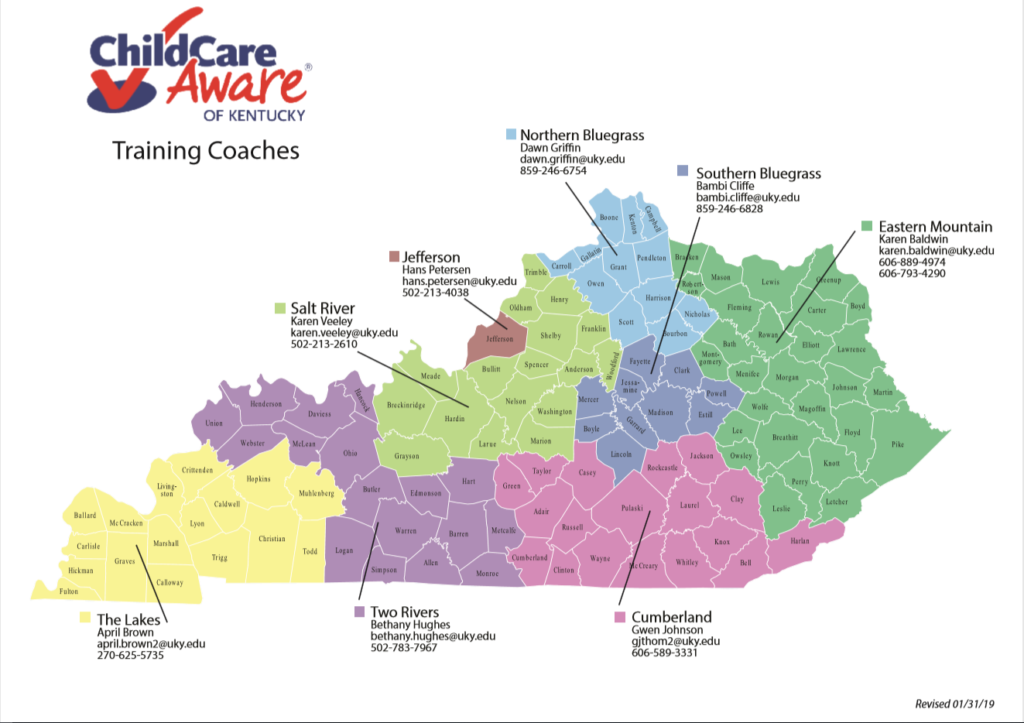Archives: Lessons
Diversity of Adult Learners S20
In every group of adult learners, there exists a wide range of diversity. Many different individuals will be present, each one of them uniquely shaped by the forces that are at work in a wide range of identity-forming cultural and life experiences.
This diversity and the factors that create it all contribute to the development of individual learning profiles that each individual training participant will bring into your training. Understanding more about human diversity will help you plan trainings that are more able to connect with and reach these diverse adult learners. This will in turn increase your chances of educating, inspiring and helping to chart a path for training participants to change their work behaviors to improve outcomes for children and families in early care and education settings.
ECE-TRIS Information Form
Trainer Credential Overview S20
Welcome to the informational section on the Trainer Credentialing process. This section will provide details about the credential itself and some helpful tips for the application process. Please pull out your FET 1: Trainer’s Credential Overview ?Handout for note-taking. You will want to jot down notes to ensure that you have a complete application the first time you submit.
Throughout the lesson there will be instructions to click on images and/or text for additional information to show. Some text will also expand and then be available. Please be sure to interact as you progress through all the sections and lessons.
[ms_panel title=”Handout” title_color=”#1a72bf” border_color=”#1a72bf ” title_background_color=”#f5f5f5″ border_radius=”0″ class=”” id=””]?Please refer to your Handout FET: FET and Trainer Credential Overview pages (2-14).?[/ms_panel]
Tips for Navigating FET S20
Throughout this training, you will encounter the following types of activities:
?Handout: This icon indicates that there is content to refer to in your FET handout.
?Think Spot: An ungraded opportunity to reflect on the topic discussed and likely is tied to the course handout. It is recommended that you download or print the handout to have on hand while you complete the courses.
? Check Your Knowledge: A graded quiz to check your understanding of the topic(s) covered. These can be True/False, Multiple Choice, or Fill in the Blank. Check Your Knowledge quizzes are complete when 80% of the questions are answered correctly (unless otherwise indicated). You may take the Check Your Knowledge quizzes multiple times until 80% is achieved.
⭐Application Assignments: A variety of graded assignments that have you apply what you have learned to demonstrate the use of specific knowledge, skills, and tools that enhance training.
▶️ Embedded Videos: Throughout the courses there are videos from various YouTube channels. These videos must be viewed in their entirety before moving on to the next topic. If you encounter a problem with a video please use the “Contact Us” button at the bottom of the page and include the name of the video or topic you are having trouble with.
? Training Coach Touchpoint: Throughout FET you will have an opportunity to reach out to your regional Training Coach to connect. This will be via assignment in the course, phone, email and/or Skype.
? Learning Boosts: You will receive brief reinforcements of content at specific time intervals following the training . These boosts are intended to aid in recalling information (recognition boost), answering an open response question (generative boost) or prompting you to think, form your own opinion and ideally compare your ideas to that of your peers (integrative boosts).
? Resources: Supplemental resources, including but not limited to, articles, links, and references.
For those of you that are new to online learning, or to Learndash in particular, it may take a little practice learning how to navigate through the course. Please feel free to contact us by phone or email.
Handouts S20
To download the handouts for the course, please click on the course title below. We ask that you print out the handouts for and take notes throughout the presentation. Throughout the courses when you see ?, you will refer to the designated page in your handouts.
Note: At the face-to-face training you will be given a binder, complete with an index and printed tabs. We will have hole punchers available and encourage you to bring any of your pre-printed handouts to insert them into your FET binder at that time. For those of you that prefer to work in electronic documents you are welcome to download each of the handouts above.
Thank you for making the decision to pursue your Trainer’s Credential. The purpose of FET is to give you the foundation to become an effective trainer who produces quality training. Producing high quality trainings is vital to early childhood professionals so they can use what they learn to provide high quality care for young children. It starts with YOU!
Let’s begin by taking a look at what is required to become a credentialed trainer in the Trainer’s Credential Overview.
Course Facilitators are your regional Training Coaches S20
This series of 12 mini courses is facilitated by eight regional Child Care Aware Training Coaches and Christine Hausman, the Professional Development Content Coordinator from Child Care Aware.
The eight regional Training Coaches and their contact information are displayed on the map below. The Training Coaches are available as a resource to you throughout FET, the credentialing process, and once you become a credentialed trainer.

Training Day
You can start or end the training day with a survey about the interests and skills of the Prenatal Outreach Representatives to also help you determine placements after you complete the training. You can use our online Prenatal Outreach Representative Survey Tool or the Microsoft Word template of the Prenatal Outreach Representative Survey and add your own modifications.
Lesson
References
Alber, R. (2019). Using video content to amplify learning. Retrieved from https://www.edutopia.org/article/using-video-content-amplify-learning
Antelope Valley College. (n.d.) Pros and cons of using various types of assessment. Retrieved from https://www.avc.edu/sites/default/files/administration/organizations/slo/ProsandConsofAssessmenttools.pdf
Barnes, M. (2013). Letting go of homework and worksheets. Putting Students at the Center. 8(11). Retrieved from http://www.ascd.org/ascd-express/vol8/811-barnes.aspx
Bob Pike Group. (2019). Quick Energizers for Live and Virtual Training. https://www.bobpikegroup.com/virtual-training-and-e-learning#register-for-our-free-webinars.
Brainstorming: Generating many radical, creative ideas. (n.d.) Retrieved from https://www.mindtools.com/brainstm.html
Brewer, E.W. (1997). 13 ways to get your message across: The essential reference for teachers, trainers, presenters, and speakers. (pp 22-27). Retrieved from http://web.utk.edu/~ewbrewer/pdf/books/13%20proven%20ways/Small-Group%20Discussion.pdf
Doumont, J.I. (2014). Panel discussions. In English communication for scientists. Unit 5.3. Retrieved from https://www.nature.com/scitable/topicpage/panel-discussions-13909630/
ECE TRIS https://tris.eku.edu/ece/content
Erickson, A. (2017). Engaging students through mini lectures. Retrieved from https://www.excelsior.edu/article/engaging-students-through-mini-lectures/
Guest Blogger. (2016). How games promote learning. Global Learning. Retrieved from https://blogs.edweek.org/edweek/global_learning/2016/01/games_promote_learning.html
Implementing posters in the classroom. (n.d.). Retrieved from https://poorvucenter.yale.edu/ImplementingPosters
Jablon, J. (n.d.) Observation in the classroom. Teaching Young Children. 4(2), 24 – 27. Retrieved from https://www.isbe.net/Documents_KIDSWebsiteResources/Taking%20it%20all%20in.pdf
Jacobs, J. (2018). The problem with worksheets. Retrieved from https://learningprofessor.com/2018/09/03/the-problem-with-worksheets/
Lee, C.D. (2014) Worksheet usage, reading achievement, classes’ lack of reading and scientific achievement: A cross-country comparison. International Journal of Education in Mathematics, Science and Technology. 2(2). 96-106. Retrieved from https://files.eric.ed.gov/fulltext/EJ1066356.pdf
Lieberman, M. (2019). Discussion boards: Valuable? Overused? Discuss. Inside Higher Ed.Retrieved from https://www.insidehighered.com/digital-learning/article/2019/03/27/new-approaches-discussion-boards-aim-dynamic-online-learning
Meador, D. (2019). Basic strategies for providing structure in the classroom. Retrieved from https://www.thoughtco.com/strategies-for-structure-in-the-classroom-4169394
Merriam, S.B. (2009). Strengths and limitations of case studies. In John Wiley & Sons Inc. (Eds.), Qualitative research: A guide to design and implementation (3). San Francisco, CA: Jossey-Bass. Retrieved from https://tomprof.stanford.edu/posting/1013
Mushimiyimana, D. (2018). Why schools should embrace debates. The New Times. Retrieved from https://www.newtimes.co.rw/education/why-schools-should-embrace-debates
Owens, A. (n.d.) The disadvantages of debates. Retrieved from https://classroom.synonym.com/disadvantages-debates-7641165.html
Reddy, C. (n.d.) Why research is important for students, humans, education. Retrieved from https://content.wisestep.com/research-important-students-humans-education/
Role play as an instructional method for adult learners. (n.d.). Retrieved from https://roleplayasaninstructionalmethodforadultlearners.weebly.com/index.html
Rubric (academic). (n.d.). Retrieved October 14, 2019, from https://en.wikipedia.org/wiki/Rubric_(academic)
Schindler, L., Puls-Elvidge, S., Welzant, H., & Crawford, L. (2015). Definitions of Quality in Higher Education: A Synthesis of the Literature. Higher Learning Research Communications, 5(3), 3. doi: 10.18870/hlrc.v5i3.244
Tersoo, A. (2018). Definition, advantages, and disadvantages of demonstration method of teaching. Retrieved from https://www.legit.ng/1142120-definition-advantages-disadvantages-demonstration-method-teaching.html
Trainers Credential Regs https://apps.legislature.ky.gov/law/kar/922/002/240.pdf
Trustees of Boston University. (n.d.) Using case studies to teach. Retrieved from https://www.bu.edu/ctl/teaching-resources/using-case-studies-to-teach/
Tips for developing job aids (n.d.). Retrieved from https://thrsc.com/essential-skills/wp-content/uploads/2015/03/Tips-for-developing-Job-aids.pdf
Application Activity
Attached is your final assignment. You will need to download, complete, and upload under “Content Design Exercise”.

Instructions:
Now that you have had the opportunity to learn more about online courses and ways in which content can be created, it’s time to put your new knowledge into practice.
In this assignment you will describe how you will present at least 1 (one) Training Outcome for an online session you are facilitating. You may use the sample provided in the course or create your own. Please note that points awarded will vary depending on which option you choose.
Complete this form in its entirety and submit using the upload button in the course. If you have any issues accessing the form, saving the form, or completing the assignment please reach out to dawn.griffin@uky.edu for assistance. Assignment must be completed satisfactory with a score of at least X out of X before being able to proceed to the remainder of the course
Example Assignment
Name: Tallulah Trainer
Training Title: Selecting Developmentally Appropriate Books and Other Print Materials for Young Children, Ages Birth through 6 years
Training Description: During this training participants will learn how to select books that are developmentally appropriate for children ages birth through 6. Participants will have a hands on opportunity to select and classify books based on skill level and genre. Participants will learn how language progresses and develops during this age and how to choose different books based on the age group they serve.
Presentation (indicate one): Live Webinar web-based online independent study
Grading Rubric
In order to successfully complete this assignment, you must score at least 7 out of 9 points.
| Assignment Component | Beginning 1 point | Developing 2 points | Advanced 3 points |
| Description of activity. | Used sample provided. | Rephrased sample provided. | Created own detailed description. |
| Training Title | Used sample title. | Rephrased sample title. | Created own detailed title. |
| Training Description | Used sample description | Rephrased sample description. | Created own detailed description. |
| Training Outcome | 1 training outcome listed. | 2 training outcomes listed. | 3 or more training outcomes listed. |
| Content Presentation | Missing or not clear how the knowledge and/or skills will be presented. | Clearly describe how you present knowledge or skills. | Clearly describe how you present at least 1 knowledge and 1 skill. |
| Training Method | Used sample method | ||
| Total Points Awarded > |
Lesson 8: Scheduling NEMT rides
Lesson 6: NEMT Private auto providers
Lesson 5: Who Can Provide NEMT Rides
Lesson 4: NEMT Covered Trips
Lesson 3: NEMT Eligibility
Lesson 2: Transportation Brokers
Learning Objective: Identify Kentucky’s Regional Transportation Brokers
In Kentucky, non-emergency medical transportation (NEMT) is administered through the Human Services Transportation Delivery program.
Lesson 1: What is Non-Emergency Medical Transport (NEMT)
Course Wrap Up
Congratulations!!
You have made it through the course requirements. A few additional items before you access your certificate.
If you have additional questions or comments about the content, please use the “contact us” button at the bottom of the page.
Please complete the form below. If you mark “no” credit for completion of this course WILL NOT be added to your ECE-TRIS professional development record.
Your individual training record in ECE-TRIS will be updated within 10 days with the course credit. ECE-TRIS is a training registry for early care and education providers and gives you 24/7 access to your professional learning record: https://tris.eku.edu/ece
Module 3: Developing your Training Plan

Now that you have an outline of what your training will be about and the outcomes you will be reviewing, let’s start working on a plan!
- In Developing your Training Plan – Part 1 you will work on the Opening Component of your Training Plan.
- In Developing your Training Plan – Part 2 you will work on the Content Delivery and Closing Components of your Training Plan.
